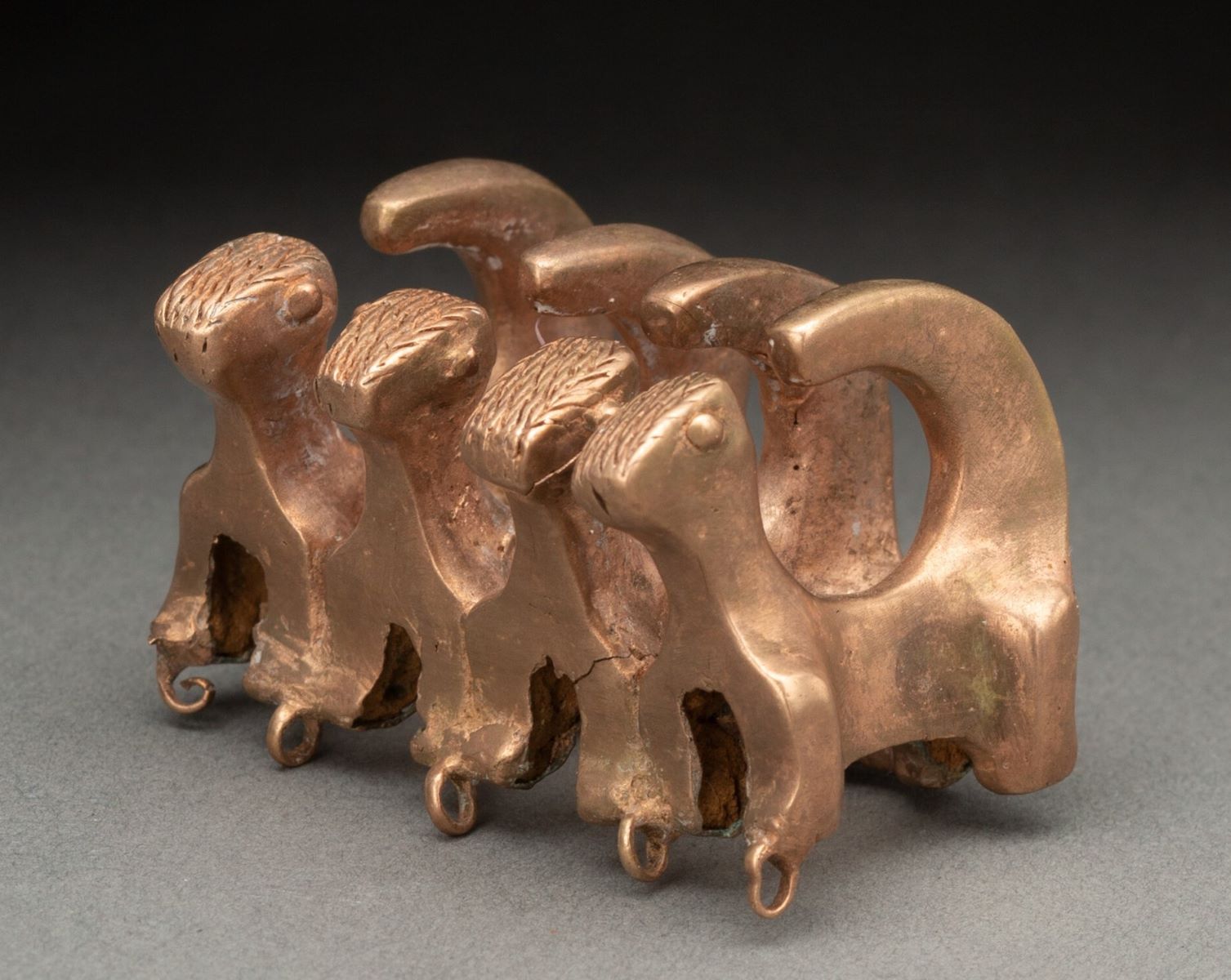
Tumbaga is a fascinating alloy that combines gold and copper, creating a unique material used by ancient civilizations in the Americas. This blend not only made the metal more durable but also allowed artisans to craft intricate designs and artifacts. Why was Tumbaga so important? Its significance lies in its versatility and the ease with which it could be worked. Ancient cultures, such as the Moche and the Inca, utilized Tumbaga for religious artifacts, jewelry, and ceremonial items. The alloy's ability to mimic pure gold while being more economical made it a prized material. Dive into these 40 facts about Tumbaga to uncover the secrets behind this ancient alloy and its impact on history.
Key Takeaways:
- Tumbaga, an ancient gold-copper alloy, was cherished by pre-Columbian civilizations for its durability, versatility, and cultural significance. It was used to create religious artifacts, jewelry, and ceremonial items, leaving a lasting impact on ancient cultures.
- Tumbaga's unique properties, including its resistance to corrosion and lower melting point than pure gold, made it a preferred material for crafting intricate religious artifacts, jewelry, and ceremonial items in ancient times. Its historical significance continues to intrigue historians and archaeologists today.
What is Tumbaga?
Tumbaga is a fascinating alloy that played a significant role in ancient metallurgy. It is primarily a mix of gold and copper, sometimes with traces of silver. This unique combination made it highly valued in pre-Columbian civilizations.
- Tumbaga is an alloy of gold and copper, sometimes containing silver.
- The name "Tumbaga" comes from the Spanish term used by conquistadors.
- It was widely used by ancient civilizations in South America, particularly the Incas and Muisca.
- The alloy's color can range from reddish to yellow, depending on the copper content.
- Tumbaga was often used to create religious artifacts, jewelry, and ceremonial items.
Historical Significance of Tumbaga
Tumbaga holds a rich historical significance, especially in the context of pre-Columbian cultures. Its unique properties made it ideal for various applications.
- The Incas used Tumbaga to craft intricate religious artifacts.
- Muisca people of Colombia are famous for their Tumbaga raft, a symbol of the El Dorado legend.
- Spanish conquistadors melted down Tumbaga artifacts to extract gold.
- Tumbaga was easier to work with than pure gold, making it popular among ancient metalworkers.
- The alloy was often used in trade among different tribes and civilizations.
Properties of Tumbaga
Tumbaga's properties make it a versatile material for various applications. Its composition and characteristics offer unique advantages.
- Tumbaga is more durable than pure gold due to the presence of copper.
- The alloy can be easily cast, hammered, and engraved.
- Tumbaga's melting point is lower than that of pure gold, making it easier to work with.
- The alloy can be polished to achieve a shiny, gold-like appearance.
- Tumbaga is resistant to corrosion, which helps preserve artifacts over time.
Uses of Tumbaga in Ancient Times
Ancient civilizations found numerous uses for Tumbaga, leveraging its unique properties for both practical and ceremonial purposes.
- Tumbaga was used to create masks for religious ceremonies.
- The alloy was fashioned into jewelry such as necklaces, bracelets, and earrings.
- Tumbaga was used to make tools and weapons, although less commonly than for decorative items.
- The alloy was often used in the creation of statues and idols.
- Tumbaga was also used to make plates, cups, and other ceremonial vessels.
Modern Understanding of Tumbaga
Today, Tumbaga continues to intrigue historians, archaeologists, and metallurgists. Modern techniques have allowed for a deeper understanding of this ancient alloy.
- Modern analysis techniques, such as X-ray fluorescence, help determine the composition of Tumbaga artifacts.
- Researchers study Tumbaga to understand ancient metallurgical techniques.
- Tumbaga artifacts provide insights into the trade networks of ancient civilizations.
- The study of Tumbaga contributes to our understanding of pre-Columbian cultures.
- Museums around the world display Tumbaga artifacts, showcasing their historical significance.
Interesting Facts About Tumbaga
Tumbaga's unique characteristics and historical context make it a subject of many interesting facts. Here are some lesser-known tidbits.
- Tumbaga can be "depleted gilded," a process that enhances its gold appearance by removing copper from the surface.
- The Spanish conquistadors often overlooked the cultural significance of Tumbaga artifacts, focusing solely on their gold content.
- Some Tumbaga artifacts have been found in shipwrecks, offering clues about ancient trade routes.
- The alloy's composition can vary widely, with some pieces containing up to 70% gold.
- Tumbaga's versatility made it a preferred material for both everyday items and high-status objects.
Preservation and Conservation of Tumbaga Artifacts
Preserving Tumbaga artifacts is crucial for maintaining our connection to ancient cultures. Conservation efforts help protect these valuable pieces of history.
- Tumbaga artifacts are often found in burial sites, where they were placed as offerings.
- Conservation techniques include cleaning, stabilizing, and sometimes restoring artifacts.
- Proper storage conditions, such as controlled humidity and temperature, are essential for preserving Tumbaga.
- Some Tumbaga artifacts have been repatriated to their countries of origin.
- Public and private collections play a role in preserving Tumbaga artifacts for future generations.
The Cultural Impact of Tumbaga
Tumbaga's influence extends beyond its physical properties. It played a significant role in the cultural and spiritual lives of ancient peoples.
- Tumbaga artifacts often depict deities, animals, and mythological scenes.
- The alloy was used in rituals to symbolize wealth, power, and divine favor.
- Tumbaga items were sometimes buried with the dead to accompany them in the afterlife.
- The craftsmanship of Tumbaga artifacts reflects the artistic skills and cultural values of ancient civilizations.
- Tumbaga continues to inspire modern artists and jewelers, who draw on its rich history and unique properties.
The Fascinating Legacy of Tumbaga
Tumbaga, a unique alloy of gold and copper, played a crucial role in ancient civilizations. Its versatility made it ideal for crafting intricate jewelry, religious artifacts, and even currency. The Spanish Conquistadors were so captivated by its beauty that they melted down countless pieces, forever altering history.
This alloy's ability to be easily molded and polished allowed artisans to create stunning works of art. Despite its historical significance, many people today remain unaware of its importance. By learning about Tumbaga, we gain a deeper appreciation for the ingenuity of ancient cultures.
Understanding Tumbaga's role in history helps us appreciate the craftsmanship and resourcefulness of those who came before us. Next time you see a piece of ancient jewelry or artifact, remember the fascinating story behind the alloy that made it possible. Tumbaga's legacy continues to shine through the ages, reminding us of our rich cultural heritage.
Frequently Asked Questions
Was this page helpful?
Our commitment to delivering trustworthy and engaging content is at the heart of what we do. Each fact on our site is contributed by real users like you, bringing a wealth of diverse insights and information. To ensure the highest standards of accuracy and reliability, our dedicated editors meticulously review each submission. This process guarantees that the facts we share are not only fascinating but also credible. Trust in our commitment to quality and authenticity as you explore and learn with us.


